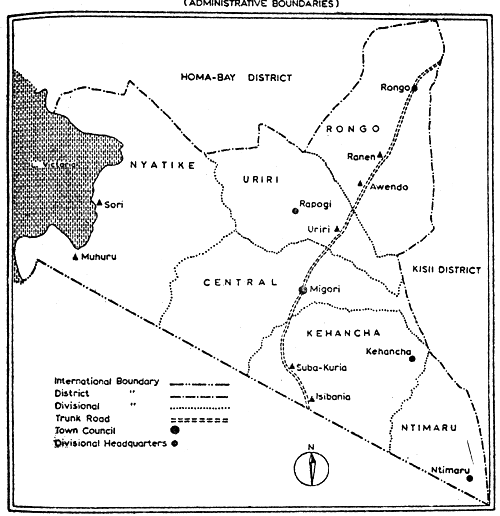The Project operates in the entire Kenyan portion of the drainage basin of Lake Victoria, covering an area of 47,700 km2 (see figure 1). There are 16 Administrative Districts covered by the Project. Due to the large area, a shortage of staff, and the difficulty in obtaining reliable data from private farmers, this report only considers the results obtained in one District. Migori District is located in the southern part of Nyanza Province, bordering Homa Bay, Kisii, Kunia & Narok Districts (see figure 2). To the South it borders Tanzania and covers a third of Kenya's shore line of Lake Victoria.
Figure I: LAKE BASIN DEVELOPMENT AUTHORITY AREA OF OPERATION

| Figure II: | MIGORI DISTRICT (ADMINISTRATIVE BOUNDARIES) |

Migori District covers 3,116 km2 with an inland water surface area of 475 km2. The population is 602,000 people, with an average density of 193/km2. Altitude varies between 1140 to 1600 m. Rainfall usually occurs through out the year with two periods of heavier rains, the long rainy season in March - May, and the short rains of October - November. Annual rain fall in the area is a minimum of 700 mm and a maximum of 1800 mm. The major agricultural activity is sugarcane production.
There are 350 active fish farmers in Migori District with 580 ponds totaling 103,820 m2. Average pond size is 180 m2, but ponds vary from 25 to 800 m2. The principal species used is Tilapia (Oreochromis) nilotica, although some farmers have stocks of Tilapia zilli and other cichlid species endemic to the streams in the area. In Migori, the Project operates a small fry production centre in Rongo from which selected strains of T. nilotica and Clarias gariepinus are reproduced and sold to farmers throughout the District.
Fish farmers who received training in Tilapia fingerling production were selected using the following criteria:
Must have at least 3 years experience in fish farming.
Must have a minimum of 2 ponds with a surface area greater than 600 m2.
Must be actively interested in fish farming, and manages existing ponds well.
Must have self-declared interest in fingerling production.
The farm must be easily accessible and located in a high potential fish farming area.
Have good public relations with the surrounding community.
Must have good stocks of T. nilotica supplied by the Project.
Honesty in all transactions with colleagues.
The training course for Tilapia fingerling producers was held in August 1993 over a period of 4 days at the main project fry production centre located at Kibos, near Kisumu. The course emphasized practical aspects of fingerling production. Topics included choice of species, spawning habits, pond management, fish physiology, care of materials 'and fingerling transport. Two levels of management for fingerling production were described. The course syllabus is in Appendix 1, all farmers who attended the course were given the same document for future reference.
Following the course, farmers were equipped with small mesh (4 mm) seine nets 10 m in length and one fish transport can (see figure 3). This material was given on a loan basis, and the farmers were expected to repay the cost of the material over a period of one year.
Project staff in Migori visited the trained farmers at least once a month. Records were kept by the farmers on how many fingerlings were sold and distributed, and these records were compiled to form the basis of this report. On several occasions, the Project purchased fingerlings from these same farmers for distribution to others in the area. This allowed verification of the quality of the fingerlings being sold, as well as giving a reasonable estimate of the quantity actually being sold by the farmers.